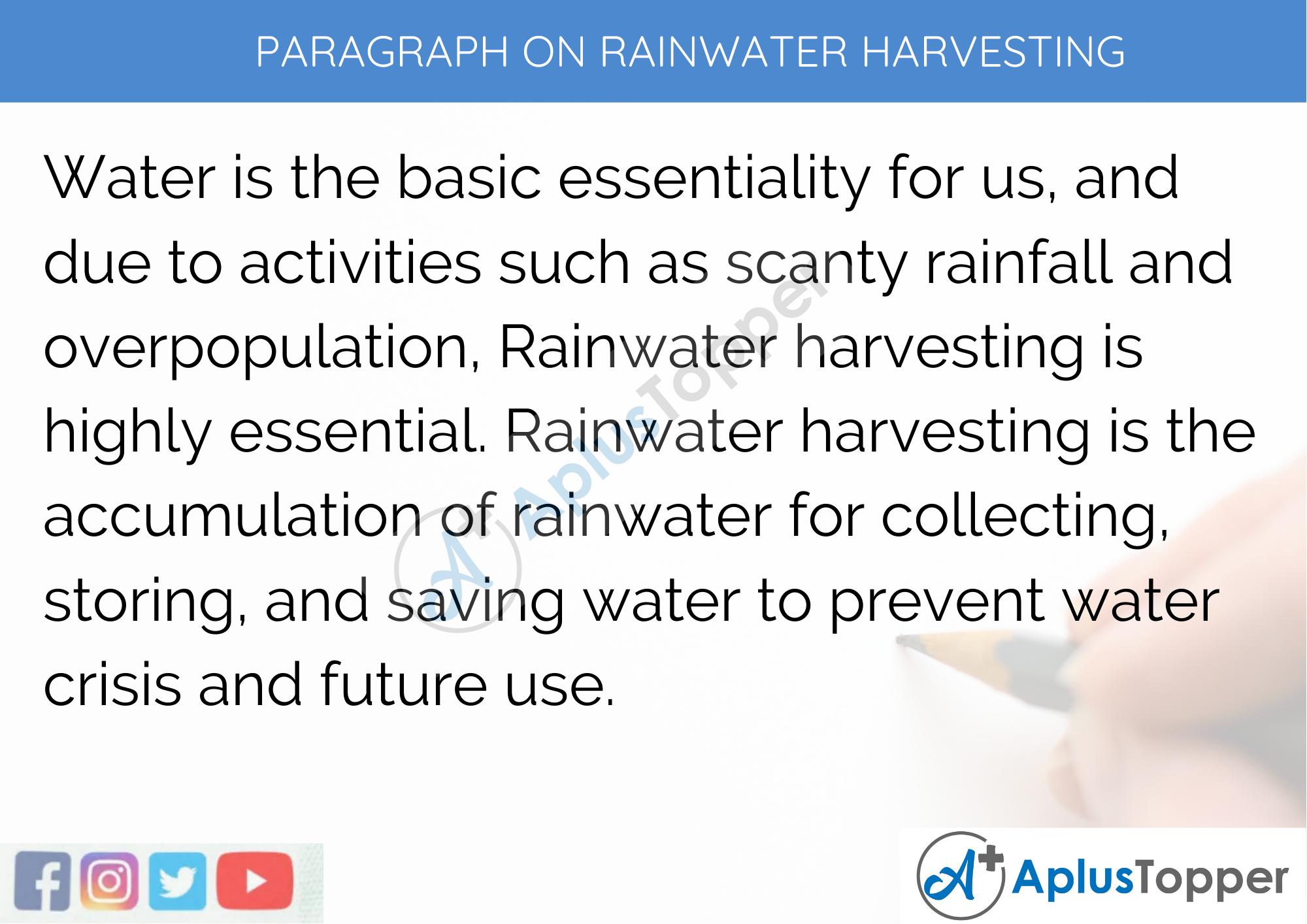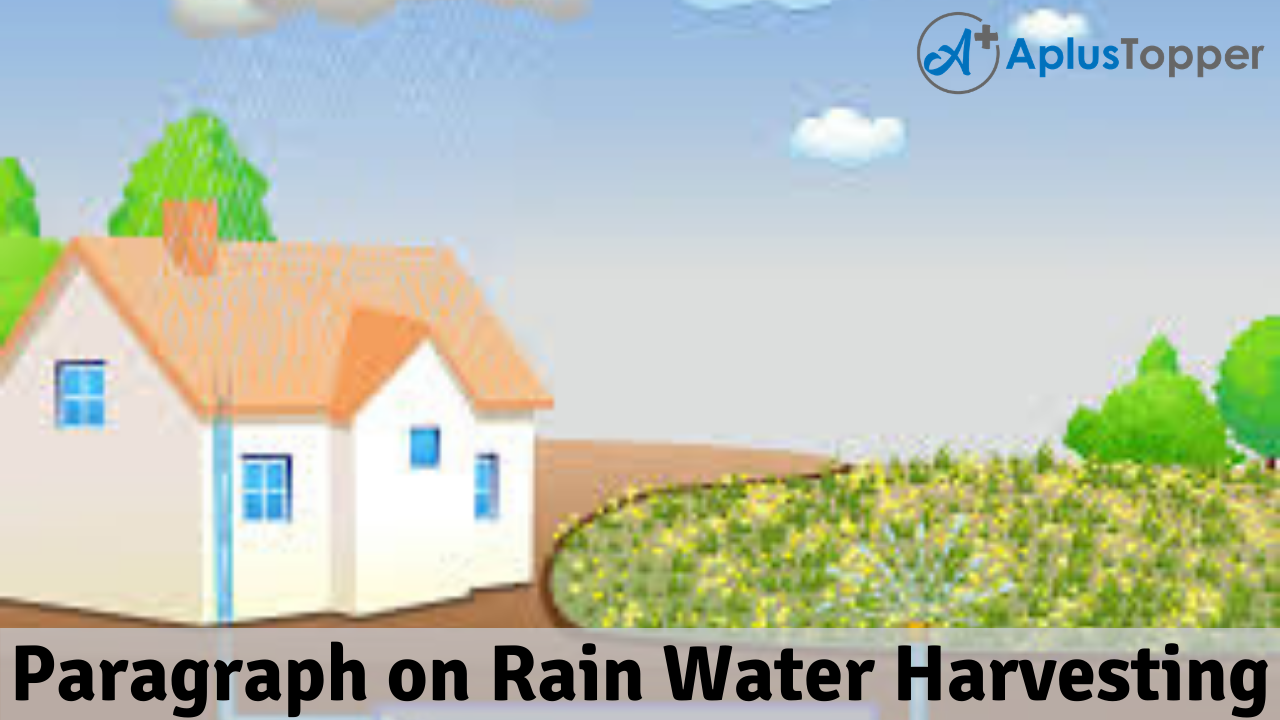Paragraph on Rain Water Harvesting: Rainwater Harvesting is a technique to collect rainwater and direct it into any natural or human-made resources. It is usually collected at the place the rain falls from the ground or rooftops.
Rainwater Harvesting is a global measure taken to prevent wastage of water. Due to the adverse effects of human activity on the environment, rainwater harvesting is gaining rapid momentum. Rain Water Harvesting is an initiation to make sensible use of natural resources.
To know more about Rainwater Harvesting, kindly read the below-mentioned paragraphs to aid you with school assignments. The paragraphs are written in simple words and small sentences to help children understand and write. Students can choose any of the following paragraphs on Rain Water Harvesting according to their needs and requirement.
You can read more Paragraph Writing about articles, events, people, sports, technology many more.
Paragraph on Rain Water Harvesting – 100 Words for Classes 1, 2, and 3 Kids
Rainwater Harvesting is a technique for directing and collecting rainwater in underground tanks. The stored water is used for watering plants and irrigation. Rainwater harvesting is a step to prevent wastage of water.
Rainwater Harvesting uses many methods to collect rainwater, such as the rooftop method of harvesting, slopes, water collection reservoirs, trenches, surface water collection, underground tanks, dams, barrages, etc.
Rainwater Harvesting implements several ways by which rainwater, such as traditional methods or any new methods and technology. Rainwater harvesting is excellent in raising groundwater levels in water shortage areas, and the harvested water ensures a smooth supply of water in the future.

Paragraph on Rain Water Harvesting – 150 Words for Classes 4 and 5 Children
Rainwater Harvesting means the collection and storage of rainwater in different containers. Rainwater harvesting requires proper filtration and keeps the water fit for any use.
The primary purpose of rainwater harvesting is to keep the rainwater conserved to recharge the underground water and store the surplus available water for the crisis. Rain falls everywhere, but it must not be allowed to run or roll downwards.
The conserved harvested water must be lifted using shallow or deep tube-wells. Rainwater harvesting provides numerous purposes for everyday routine. The stored water is used for agricultural purposes or filtered to be used as drinking water.
Rainwater harvesting can be used to store water under the surface or in a reservoir. The stored water is later used with the use of containers, or tubes, or pipes. Rainwater can also be filled in canals, big ditches, watercourses, or ponds, to replenish the water storage.
With the water crisis becoming a significant issue, rainwater can help recharge stored water and ensure water availability in scare zones. Rainwater harvesting can be practiced in apartments as well as in individual homes.
Paragraph on Rain Water Harvesting – 200 Words for Classes 6, 7, and 8 Students
Rainwater Harvesting refers to the accumulation, storage, and preservation of rainwater for its future use. Rainwater Harvesting is vital as it meets the local municipal water demands and reduces the overall capital expenditure.
Rainwater harvesting meets a lot of purposes- it can be used for industrial, domestic, and agricultural purposes. Rainwater can be purified before using it for drinking purposes and other routine activities.
Benefits of Rainwater Harvesting
- Rainwater Harvesting positively affects underground water quality. It dilutes the number of nitrates, fluorides, and the salinity of the underground water.
- It contains zero hardness and almost neutral pH, making it highly suitable for industries, homes, institutions, industries, and other commercial establishments.
- Rainwater Harvesting reduces water supply bills.
- It is an excellent method that solves the water shortage crisis and lessens the energy consumption in water disturbance.
- Rooftop Rainwater harvesting controls urban flooding.
- Recharge of rainwater to the ground in the coastal regions prevents the seawater immersion into the freshwater.
- Rainwater harvesting is an alternative to reduce the stress of public water supply sources.
- Construction of deeper wells can damage the natural environment as well as upscale. Therefore, the source of rainwater is highly effective and dependable. Stored harvested rainwater can be used as an alternative to municipal water and used during the water crisis.
Conclusion
Rainwater Harvesting holds vast benefits. To function well, rainwater harvesting systems have to be designed performed and maintained to ensure and maintain the quality of water. The harvested water needs to be purified and filtered before consumption or for other purposes.
Paragraph on Rain Water Harvesting – 250 to 300 Words for Classes 9, 10, 11, 12 and Competitive Exam Students
Water is the basic essentiality for us, and due to activities such as scanty rainfall and overpopulation, Rainwater harvesting is highly essential. Rainwater harvesting is the accumulation of rainwater for collecting, storing, and saving water to prevent water crisis and future use.
Rainwater is collected from the rooftop and is directed through tubes or pipelines into a storage tank to save the remaining water. Rainwater harvesting is of high quality and is a sustainable source of water.
Rain Water Filtration
Rainwater can be harvested or purified in multiple ways. The catch area before harvested must be cleaned thoroughly, and the pipelined must be flushed regularly. Initially, the water flow is diverted to wash or rinse the area.
Rainwater contains contaminants or other waste materials that affect the quality of the water. Contaminants such as dust, Bird excreta, pollution, leaves, and sand particles can affect water quality.
Filteration removes contaminants and other impurities and purifies rainwater for drinking and other purposes. However, the harvested water has to treated and tested before consumption to ensure the right quality check.
Industries use the practice of pre-filtration to ensure that the purified water is directed water to the tank. The pre-filtration measure is a vital step that the water supply system should not compromise in terms of water quality.
Some techniques of rainwater purification are solar sterilization, use of chemicals like iodine or chlorine, or sediment filtration. However, harvested rainwater used for drinking purposes can be filtered through Reverse Osmosis (RO).
Conclusion
Thus, several methods incorporate water purification. Rainwater used as drinking water must not be consumed without purification and filtration.

FAQ’s on Paragraph on Rain Water Harvesting
Question 1.
What is known as Rainwater Harvesting?
Answer:
Rainwater Harvesting refers to the accumulation, storage, and preservation of rainwater for its future use.
Question 2.
Stae three benefits of Rainwater harvesting?
Answer:
Rainwater harvesting is an alternative to reduce the stress of public water supply sources. The recharge of rainwater to the ground in the coastal regions prevents the seawater immersion into the freshwater. Finally, rainwater harvesting reduces water supply bills.
Question 3.
How can harvested rainwater be purified?
Answer:
Some techniques of rainwater purification are solar sterilization, use of chemicals like iodine or chlorine, or sediment filtration. However, harvested rainwater used for drinking purposes can be filtered through Reverse Osmosis (RO).
Question 4.
How can rainwater be harvested?
Answer:
Rainwater harvesting can be used to store water under the surface or in a reservoir. The stored water is later used with the use of containers, or tubes, or pipes. Rainwater can also be filled in canals, big ditches, watercourses, or ponds, to r
